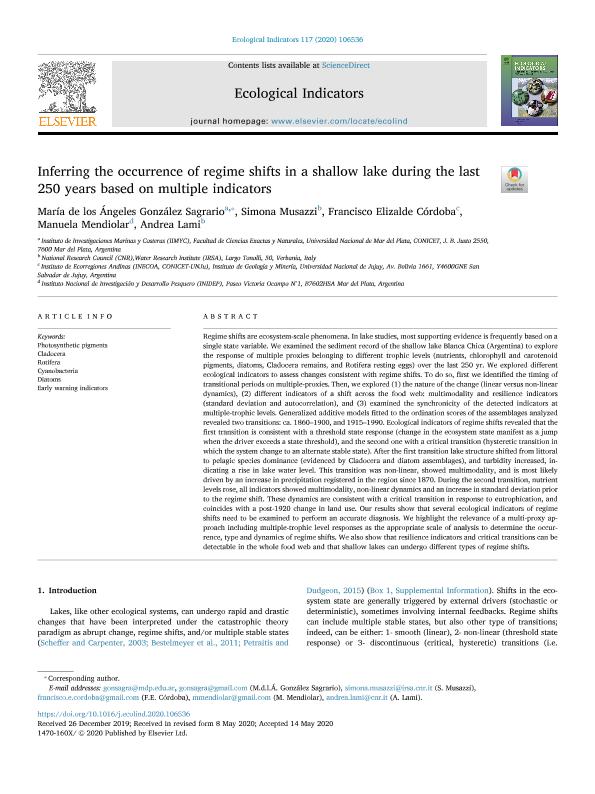Mostrar el registro sencillo del ítem
dc.contributor.author
Gonzalez Sagrario, Maria de Los Angeles

dc.contributor.author
Musazzi, Simona
dc.contributor.author
Cordoba, Francisco Elizalde

dc.contributor.author
Mendiolar, Manuela

dc.contributor.author
Lami, Andrea

dc.date.available
2021-03-12T21:08:16Z
dc.date.issued
2020-05
dc.identifier.citation
Gonzalez Sagrario, Maria de Los Angeles; Musazzi, Simona; Cordoba, Francisco Elizalde; Mendiolar, Manuela; Lami, Andrea; Inferring the occurrence of regime shifts in a shallow lake during the last 250 years based on multiple indicators; Elsevier Science; Ecological Indicators; 117; 106536; 5-2020; 1-16
dc.identifier.issn
1470-160X
dc.identifier.uri
http://hdl.handle.net/11336/128300
dc.description.abstract
Regime shifts are ecosystem-scale phenomena. In lake studies, most supporting evidence is frequently based on a single state variable. We examined the sediment record of the shallow lake Blanca Chica (Argentina) to explore the response of multiple proxies belonging to different trophic levels (nutrients, chlorophyll and carotenoid pigments, diatoms, Cladocera remains, and Rotifera resting eggs) over the last 250 yr. We explored different ecological indicators to assess changes consistent with regime shifts. To do so, first we identified the timing of transitional periods on multiple-proxies. Then, we explored (1) the nature of the change (linear versus non-linear dynamics), (2) different indicators of a shift across the food web: multimodality and resilience indicators (standard deviation and autocorrelation), and (3) examined the synchronicity of the detected indicators at multiple-trophic levels. Generalized additive models fitted to the ordination scores of the assemblages analyzed revealed two transitions: ca. 1860–1900, and 1915–1990. Ecological indicators of regime shifts revealed that the first transition is consistent with a threshold state response (change in the ecosystem state manifest as a jump when the driver exceeds a state threshold), and the second one with a critical transition (hysteretic transition in which the system change to an alternate stable state). After the first transition lake structure shifted from littoral to pelagic species dominance (evidenced by Cladocera and diatom assemblages), and turbidity increased, indicating a rise in lake water level. This transition was non-linear, showed multimodality, and is most likely driven by an increase in precipitation registered in the region since 1870. During the second transition, nutrient levels rose, all indicators showed multimodality, non-linear dynamics and an increase in standard deviation prior to the regime shift. These dynamics are consistent with a critical transition in response to eutrophication, and coincides with a post-1920 change in land use. Our results show that several ecological indicators of regime shifts need to be examined to perform an accurate diagnosis. We highlight the relevance of a multi-proxy approach including multiple-trophic level responses as the appropriate scale of analysis to determine the occurrence, type and dynamics of regime shifts. We also show that resilience indicators and critical transitions can be detectable in the whole food web and that shallow lakes can undergo different types of regime shifts.
dc.format
application/pdf
dc.language.iso
eng
dc.publisher
Elsevier Science

dc.rights
info:eu-repo/semantics/openAccess
dc.rights.uri
https://creativecommons.org/licenses/by-nc-nd/2.5/ar/
dc.subject
CLADOCERA
dc.subject
CYANOBACTERIA
dc.subject
DIATOMS
dc.subject
EARLY WARNING INDICATORS
dc.subject
PHOTOSYNTHETIC PIGMENTS
dc.subject
ROTIFERA
dc.subject.classification
Otras Ciencias de la Tierra y relacionadas con el Medio Ambiente

dc.subject.classification
Ciencias de la Tierra y relacionadas con el Medio Ambiente

dc.subject.classification
CIENCIAS NATURALES Y EXACTAS

dc.title
Inferring the occurrence of regime shifts in a shallow lake during the last 250 years based on multiple indicators
dc.type
info:eu-repo/semantics/article
dc.type
info:ar-repo/semantics/artículo
dc.type
info:eu-repo/semantics/publishedVersion
dc.date.updated
2021-02-17T20:09:02Z
dc.journal.volume
117
dc.journal.number
106536
dc.journal.pagination
1-16
dc.journal.pais
Países Bajos

dc.journal.ciudad
Amsterdam
dc.description.fil
Fil: Gonzalez Sagrario, Maria de Los Angeles. Consejo Nacional de Investigaciones Científicas y Técnicas. Centro Científico Tecnológico Conicet - Mar del Plata. Instituto de Investigaciones Marinas y Costeras. Universidad Nacional de Mar del Plata. Facultad de Ciencias Exactas y Naturales. Instituto de Investigaciones Marinas y Costeras; Argentina
dc.description.fil
Fil: Musazzi, Simona. Consiglio Nazionale delle Ricerche; Italia
dc.description.fil
Fil: Cordoba, Francisco Elizalde. Universidad Nacional de Jujuy. Instituto de Ecorregiones Andinas. Consejo Nacional de Investigaciones Científicas y Técnicas. Centro Científico Tecnológico Conicet - Salta. Instituto de Ecorregiones Andinas; Argentina. Consejo Nacional de Investigaciones Científicas y Técnicas; Argentina
dc.description.fil
Fil: Mendiolar, Manuela. Instituto Nacional de Investigaciones y Desarrollo Pesquero; Argentina
dc.description.fil
Fil: Lami, Andrea. Consiglio Nazionale delle Ricerche; Italia
dc.journal.title
Ecological Indicators

dc.relation.alternativeid
info:eu-repo/semantics/altIdentifier/url/https://www.sciencedirect.com/science/article/abs/pii/S1470160X20304738?via%3Dihub
dc.relation.alternativeid
info:eu-repo/semantics/altIdentifier/doi/https://doi.org/10.1016/j.ecolind.2020.106536
Archivos asociados
